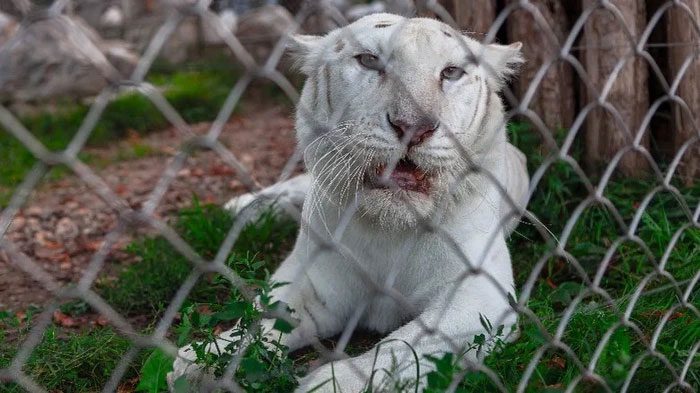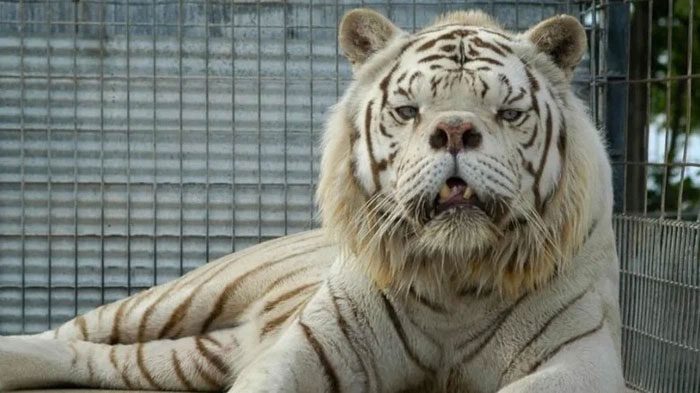Contrary to popular belief, white tigers are not a distinct species or even a subspecies, such as Bengal or Siberian tigers.
In fact, the unique coloration of white tigers is caused by a genetic mutation, although it is extremely rare. The white color in these tigers is a form of leucism – a partial loss of pigmentation due to genetics – leading to a lack of red, orange, and yellow across their bodies.
While their white coloration is not necessarily a harmful condition, human breeding practices have resulted in some rare mutations that are detrimental to their survival.
Wild White Tigers

One hundred years ago, there were approximately 100,000 wild tigers roaming the forests and grasslands of Asia and Eastern Europe. However, as of 2023, habitat loss and poaching have reduced their numbers to about 4,500, putting all six surviving subspecies at severe risk.
White tigers were originally born outside of nature and are extremely rare (with none being born in the wild for over 65 years).
Tigers are nocturnal ambush predators, relying on their camouflage to sneak up on prey. Tiger cubs spend months learning how to stalk and kill prey effectively from their mothers before venturing out on their own.
In fact, hunting in the wild is very challenging – about 50% of wild tiger cubs do not survive their first two years. Unlike their orange counterparts, white tigers stand out against their forest and habitat environments. This means they face significant disadvantages when stalking prey – large mammals such as deer and wild boar.
This lack of camouflage also makes white tigers more susceptible to attacks. Although they are apex predators, young or weak tigers can fall prey to crocodiles, snakes, leopards, other tigers, and even pack-hunting wild dogs known as dholes.
Additionally, white tigers are also more likely to have genetic vision problems. With natural selection working against them, it is likely that most wild white tigers die from starvation.
 Since the first white tigers were showcased in India in the 1950s, people have seen the potential for profit from these rare cats. According to Science Reporter, Mohan – a white tiger captured as a cub in India in 1951 – was the father of a total of 34 offspring, 21 of which were born white.
Since the first white tigers were showcased in India in the 1950s, people have seen the potential for profit from these rare cats. According to Science Reporter, Mohan – a white tiger captured as a cub in India in 1951 – was the father of a total of 34 offspring, 21 of which were born white.
Despite their extreme rarity, Bengal white tigers can sometimes survive in the wild. Unfortunately, their scarcity only makes them more appealing to hunters.
According to Science Reporter, writer Abul Fazal documented the existence of the first white tigers in India in 1561. In the second volume of “The Akbarnama” – a historical account of Emperor Akbar’s reign – Fazal described his retinue hunting and killing a female tiger and her five cubs in the forests near the town of Narwar using swords and arrows. In one of the accompanying illustrations in the book, two of the cubs are depicted with bright white fur.
By the late 1800s, encounters with white tigers in history almost always ended with gunfire, and over the years, the hunting of rare animals has increased.
As noted by the Journal of the Bombay Natural History Society, 17 white tigers were shot in India between 1907 and 1933. The most common white tigers were found in the forests near Rewa, a city in the state of Madhya Pradesh, India. Occasionally, hunters would bring live white tigers back for display, such as a white tiger captured in 1915 and a cub named Mohan who was kept alive after his family was killed.
Sadly, wild white tigers have not been seen in India since the last one was shot by a hunter in 1958.

Due to the dominant gene coding for orange fur, most tigers are born orange, even if one or both parents are white. As a result, tiger breeders have produced many orange cubs in the search for white tigers. Worse, many of the white cubs that were born died, were unhealthy, or severely deformed due to inbreeding.
All Captive White Tigers are Artificial Products
In the wild, only about 1 in 10,000 tigers has white fur. Aside from being extremely rare, the genetic mutation causing the white color is a recessive gene, meaning a tiger must inherit a copy from both parents to be born white. Simply put, there are not many white tigers in nature.
The most effective way to produce more white tigers is to breed two white tigers together. Most of the approximately 200 white tigers currently in captivity are descendants of a wild Bengal tiger named Mohan, captured in India in 1951. Instead of waiting to encounter more white tigers, Mohan’s keepers continuously bred him with his daughter and granddaughter to produce subsequent white tigers.
According to veterinarian Daniel Laughlin in an article he wrote for Big Cat Rescue, a U.S. zoo was the first to breed a Bengal tiger with a Siberian tiger, then allowed their offspring to breed with each other, resulting in a few white cubs being born. One of these tigers was then bred with a white tiger from Mohan’s lineage, producing all the white tigers currently in the United States. With such a small gene pool, every modern white tiger is in a state of severe inbreeding.

In addition to suffering from numerous health issues related to inbreeding, many white tigers also suffer from health problems directly related to their unique coloration. Like albino animals, white tigers are more sensitive to sunlight. The loss of pigmentation makes them more susceptible to sunburn, and many develop skin cancer.
White Tigers Face Many Serious Health Issues
While their white fur may reduce a tiger’s chances of survival in the wild, it does not inherently cause health problems.
However, inbreeding does. Because the genes responsible for white coloration are recessive, the quickest way to produce a white tiger is through inbreeding – that is, breeding two closely related tigers together.
In addition to selecting for a recessive trait – such as whiteness – inbreeding also inadvertently selects for a range of other recessive traits, many of which are harmful.
Repeated inbreeding further concentrates these detrimental traits, leading to a general decline in fitness, health, and reproductive ability, known as inbreeding depression.
Along with the desired white fur, many health issues, including facial deformities, spinal abnormalities such as scoliosis, organ defects, cleft palate, hip dysplasia, clubfoot, bulging eyes, short legs, inability to swallow and digest food, neurological disorders, infertility, weakened immune systems, and heart problems, also increase.

Widespread irresponsible breeding to produce white tigers has damaged the gene pool of tigers. Even if they appear healthy, all white tigers – as well as many standard orange tigers born during the white tiger breeding process – are products of inbreeding. Many are also hybrids of the two most commonly bred tiger subspecies, the Bengal tiger from India, Bangladesh, and Nepal, and the Siberian tiger from China and Russia, making them useless for captive breeding programs and reintroduction into either population.


















































